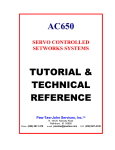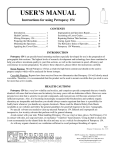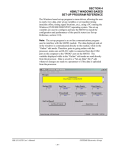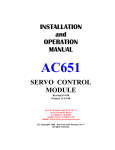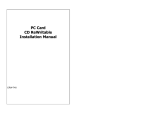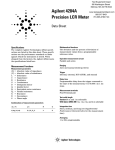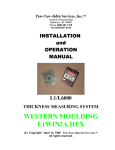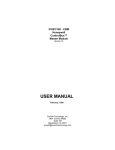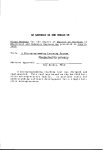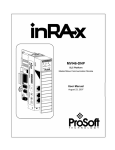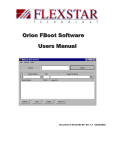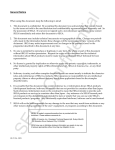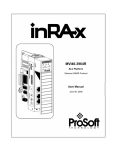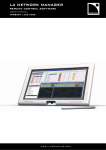Download MVI Manual1 - Paw-Taw
Transcript
ALLEN-BRADLEY MVI SETUP 11/11/02 Paw-Taw-John Services, Inc.TM Allen-Bradley MVI46ADM & Servo Sensor® Interfacing USER MANUAL Table of Contents Page OVERVIEW 1 1.2 Features 1.3 Communicaitons Port Particulars of the MVI46ADM interface 1.4 MVI-ADM/PLC timing 1 1 1 2.0 Cabling Hookup to MVI46 Module 2.1 Items required 2.2 Connections Procedure of Servo Sensor® to MVI46 3.0 Front Panel Description 4.0 Applying Power to the PLC and Servo Sensor® 5.0 PLC Programming with the MVI46 6.0 MVI46/ADM Configuration/Setup 7.0 MVI46ADM Programming Notes 8.0 MVI and the HYPER-Terminal (NOT USED) 9.0 Using the Servo Sensor® Setup Software 2 2 2 2 2 2 7 7 8 10 FIGURES Figure 1. Advanced Configuration Screen Figure 2. Communication Tab Figure 3. "n" display Figure 4. "s" display Figure 5. "p" display Figure 6. Typical EZ Touch Programming Screen Figure 7. EZ Touch Numeric Entry Screen Figure 8. Typical PLC ladder Frame Figure 9. IC Installation APPENDIX'S A: SERVO SENSOR CONTROLLER REPLACEMENT B:INSTALLATION CONSIDERATIONS C: COMMAND CODE STRUCTURE DRAWINGS MVI Block Diagram MVI Connect Diagram Connectorv21 Diagram 3 5 6 6 7 8 8 9 11 1.0 OVERVIEW 1.1 This motion control system integrates a SLC500 PLC, an MVI46ADM module mounted on the back plane of the PLC, and one to sixteen Servo Sensors™. PLC ladder logic uses predetermined memory locations and a command structure for motion control to the Servo Sensor™. The communications network from the MVI module to the Servo Sensors™ utilizes a two wire RS-485 multi-drop configuration. Refer to MVI500CONNECT.DWG sheet 1 of 5. 1.2 Features Provides interfacing to S-series MTSServo Sensors™. One to sixteen Servo Sensors™ controlled from one MVI module. Two RS485 ports-each controlling eight ServoSensors™ each. One RS232 Com port used by PC to interface Servo Sensor™ setup software if required. Hyper-terminal mode can be used to determine status within MVI. Translator program is loaded in MVI from front of module using RS232 Com port. Communication format is ASCII code. Easy machine motion control programming. N: memory locations used for loading commands, targets, velocities, and reading status. For Servo Sensor™ specifications, refer to MTS. 1.3 Communications Port Particulars of the MVI46ADM interface Port 1 • Port 1 used to communicate with a Personnel Computer • Port 1 baud-rate is 19.2kb. • Translator Software loaded through this port. • Used to interface a Personal Computer. • Servo Sensor™ setup software is operated through this port. • Hyper-terminal link is run through this port. Port 2 • Port 2 used to communicate to the Servo Sensor™ network. • Port 2 baud-rate fixed at 115.2 KB. • Port 2 network will communicate with 1 to 8 Servo Sensors™ • Communication is RS485. • ASCII code is the protocol used. Port 3 • Port 3 used to communicate to the Servo Sensor™ network. • Port 3 baud-rate fixed at 115.2 KB. • Port 3 network will communicate with 1 to 8 Servo Sensors™ • Communication is RS485. • ASCII code is the protocol used. 1.4 MVI-ADM/PLC timing Approximately 12msec update time between backplane and MVI. Servo Sensor™ update time on Com port 2 & 3 is ~3.5msec per probe. This document assumes that the user has computer-keyboarding skills and knowledge of personal computers. If not, operation by unqualified personnel can cause degraded results, non- operation, failures, and possible down time. ProSoft MVI46ADM Interface 08/13/04 Paw-Taw-John Services, Inc. Copyright 2002 1 2.0 CABLING HOOKUP TO MVI46 MODULE 2.1 Items required • • • • • • • • RJ-45 to 9 pin connector cables. (Supplied with MVI module). D-9 to terminal breakout adapter. (Supplied with MVI module). Refer to PTJ drawing MVI500CONNECT.DWG sheet 2. Three position terminal strip or equivalent. S-Series Servo Sensor™ controller Power/Communications cable with connector for Servo Sensor™ or pigtail for use in multi-drop systems. +24VDC Power Supply capable of supplying enough current for the system. Small screwdriver 2.2 Connection Procedure of Servo Sensor™ to MVI46 • Connect supplied communications cable to P2 or P3 • Plug 9-pin connector into terminal breakout adapter. • Install power/communications cable as follows: • Hook white wire (part of shielded pair) to 1 of the terminal breakout adapter. • Black wire (part of shielded pair) to 8. • Install jumper from negative 24 VDC Power Supply to 5. • Ensure good connections. These wires are small and might not make good initial contact. • Refer to MVI500CONNECT.DWG for terminals of other wires in the power/communications cable. 3.0 FRONT PANEL DESCRIPTION • • • P1 LED will flash if communications are active with PC. P2 and P3 LEDS will flash if communications are active between MVI and Servo Sensors™. BP LED will flash 200 Msec on and 200 Msec off. This indicated the MVI module is working 4.0 APPLYING POWER TO THE PLC AND SERVO SENSOR™ After connecting, installing, and configuring the MVI46 and the Servo Sensor™, please follows the procedure stated below. “CAUTION: Check all power for correct levels. +24vdc should be 24 +/- .05%.” 4.1 Procedure • Connect the Power/Com cable to the Servo Sensor™ • Apply 24vdc power to the system. • The expected responses are as follows: • BP lamp is flashing at a fast rate. • Depending on the communications port used either P2 (port2) and/or P3 (port3) will be flashing. 5.0 PLC PROGRAMMING WITH THE MVI46 This document assumes that the user has computer-keyboarding skills, has PLC programming skills, knowledge of personal computers, and PLC’s. If not, integration by unqualified personnel can cause degraded results, non- operation, failures, and possible down time. 5.1 Items required. • Notebook or equivalent PC • RSLOGIX 500 software. • RSLINX software • Optional: AB displays • Optional: Automation Direct EZ Touch display • Optional: EZ Touch Editor Software • Optional: Servo Sensor™ setup software ProSoft MVI46ADM Interface 08/13/04 Paw-Taw-John Services, Inc. Copyright 2002 2 5.2 An Excel spreadsheet Appendix C contains the memory structure, the command structure, and notes of how the commands are used. Program MVI46-SS1 transfers 33 words of status and setup data from MVI46 to N30:0. One hundred (100) words of received data from MVI46 are stored in N31:0. One hundred (100) words of data are sent to MVI46 from N32:0 First Word of data received by PLC From MVI46 must be returned in first data word sent back to MVI46 (N31:0 to N32:0). 5.3 Use advanced configuration I/O to setup MVI using 500 software. Entries shown as follows: Figure 5.1 Figure 5.2 SLC 500 CPU MVI46 ProSoft MVI46ADM Interface 08/13/04 Paw-Taw-John Services, Inc. Copyright 2002 3 Figure 5-2 ADM Main program The above picture shows the rungs used in the main body of a program. Note the jump instructions to sub routines. ProSoft MVI46ADM Interface 08/13/04 Paw-Taw-John Services, Inc. Copyright 2002 4 Figure 5-3 ADM DATA Screen The above picture shows a subroutine ladder that the PLC needs with the MVI module. Change the Integer (N:XX) locations when needed. ProSoft MVI46ADM Interface 08/13/04 Paw-Taw-John Services, Inc. Copyright 2002 5 Figure 5-4 ADM CMDS Ladder Figure 5-5 Continuation of ADM CMDS ladder ProSoft MVI46ADM Interface 08/13/04 Paw-Taw-John Services, Inc. Copyright 2002 6 6.0 MVI46/ADM CONFIGURATION/SETUP The PTJ software package incorporates all required files including the Servo Sensor™ interface program. 6.1 Items required. 1. SLC500 PLC platform with available slot 2. MVI46ADM module from ProSoft Technology, Inc. 3. PTJ Translator program (abslc-ss1.IMA) 4. MVI Tools Software. (Contains manual, etc.) 6.2 Program Loading Procedure 1 (Recommended) 1. The program can also be loaded to the MVI as a ROM Disk Image. 2. Refer to Prosoft Technology Manual 5.3. 3. All files required for the MVI are contained in the program named abslc-ss1.IMA This is a WINIMAGE file. 4. Remove power from PLC. 5. Move jumper JP3 from Run/Clear to Setup. 6. Connect PC to Port 1 using the supplied null modem cable and RJ45/9pin cable. 7. Start MVI Flash Update Utility program. Program is supplied with ADM package. 8. Select Com Port. 9. Power up module. 10. Choose file ***.IMA (abslc-ss1.IMA) 11. Download. 12. Remove Power. 13. Move jumper JP3 to engage only the Run/Clear pin. 14. Power up module. 15. MVI is ready for operation. 16. Move JP1 and JP2 to RS485. 7.0 MVI46ADM PROGRAMMING NOTES The following discussions will explain some of the basic criteria that the PLC programmer should consider when writing the program. Since every programmer has their own approach, the explanations are only for idea purposes. Appendix C lists the command structure. PLC Leading Particulars Consider the stroke of the Servo Sensors™ at all times when sending targeting information and viewing position information. All commands to/from the MVI are listed in decimal format. Hex/Octal equivalents can be used. The target value can not exceed the programmed stroke of the Servo Sensor™. Device ProSoft MVI46ADM SLC500 Table 7-0 Programs Program Abslc-ss1.IMA MVI46-SS.RSS ProSoft MVI46ADM Interface 08/13/04 Paw-Taw-John Services, Inc. Copyright 2002 Description Servo Sensor™/MVI translator Basic Sample 7 8.0 MVI AND THE HYPER-TERMINAL (NOT USED PRESENTLY) Displays showing the MVI program name, buffer status, and active Servo Sensors™ are viewed with this method. 8.1 Item required. • • RJ45/9 pin cable (supplied with MVI module) Null modem cable (supplied with MVI module) 8.2 Procedure • Connect cable between P1 of the MVI and the Com port connector on the PLC. • Apply Power. • The BP lamp will flash if MVI is working. • P2 and/or P3 will flash indicating the PC COM port is active. • Create a hyper-terminal link in the PC using 19.2kb, 8-n-1. • Change the Number of Servos memory location to 902 if com port two is used or 903 if com port 3 is used. • The following commands will display information as described. • Lower case “n” displays Coprocessor program name, date, and active Servo Sensor™ names and serial numbers on the network. Refer to Figure 1. • Lower case “s” continuously displays all servo positions and status. Refer to Figure 2. • Lower case “p” continuously displays in buffer from plc. Refer to Figure 3. CAUTION: MAKE SURE THAT THE SYSTEM IS NOT LEFT IN ONE OF THE CONTINUOS MODES. THE SYSTEM WILL SLOW DOWN BECAUSE OF THE 19.2KB TRANSMISSION. • Strike any other key to leave these modes. Figure 8-1 “n” display Figure 1 is a copy of the actual screen when using the hyper terminal feature. As noted previously, the program name and date is shown on the first line. The “number of servos” indicates the number of Servo Sensors™ on the network. Below this header the program name, date, and serial number is shown. Figure 8-2 “s” display ProSoft MVI46ADM Interface 08/13/04 Paw-Taw-John Services, Inc. Copyright 2002 8 The screen to the left illustrates a typical display when one Servo Sensor™ is called. The target position represents an operator position selection. The Position column reflects the actual position of the magnet on the Servo Sensor™ wand. The Status number equates to a 16bit word that is sent from the Servo Sensor™ back to the controller. Each bit within the Status word represents a particular function is active. Figure 8-3 “p” display Figure 3 shows the data calls from the PLC. IN0=# is the number of Servo Sensors™ that are programmed for the ladder logic program. This is determined in V2000 memory location. SV1 shows the command located in V2001. The next column is the target value located in V2002. The third column represents the velocity value sent to the Servo Sensor™. Its memory location is V2003. All other numbers in the columns are “trash numbers” in memory locations for other Servo Sensors™ that are not used. ProSoft MVI46ADM Interface 08/13/04 Paw-Taw-John Services, Inc. Copyright 2002 9 9.0 USING SERVO SENSOR™ SETUP SOFTWARE The Servo Sensor™ setup software may be used for programming the Servo Sensors™ via the MVI module. If parameter access is not programmed within the PLC ladder logic, this method is used. Figure 9-1. Monitor (Run) Screen Items required • • RJ-45 cable with 9 pin D female connector installed on one end. (This assembly comes with the purchase of the MVI Module.) Null Modem cable (Supplied with MVI module) Procedure • RSLOGIX 500 and RSLINX software must be off. When the software is in use, the Setup software will have a conflict with the communications port. • Connect cable between P1 CFG jack of the MVI and the Serial port of the PLC. • Load N:32/3 Word 3 with 902 decimal for com port 2 or 903 decimal for com port 3. This could be a switched input. • This switches the MVI active port to Port 1 CFG (RS-232). • Select the Servo Sensor™ setup icon. • The set up program will start. • The next 3 steps may not be required if the Servo Sensor™ setup software is already configured to communicate at 19.2kb. • After the splash screen is finished, select the Com tab. ProSoft MVI46ADM Interface 08/13/04 Paw-Taw-John Services, Inc. Copyright 2002 10 Figure 9-2. Communication Tab • • • Change the baud rate to 19.2kb and verify the pc com-port that is used. Select the Apply and Test Settings bar to restart a new search for the Servo Sensors™ on the network. The program will acknowledge the units on the network and the program can now be used to program/setup the selected Servo Sensor™/s. Follow the Servo Sensor™ manual or the help function of the software. ProSoft MVI46ADM Interface 08/13/04 Paw-Taw-John Services, Inc. Copyright 2002 11 APPENDIX A: SERVO SENSOR CONTROLLER REPLACEMENT Recommended SS removal and installation procedures are very important to minimize downtime and prevent further system damage. This chapter covers the steps for replacement of SS used with hydraulic cylinders. Some cylinders have probe guards attached to the end of the cylinder to prevent SS damage. Other cylinders have the probe cap and cable completely enclosed. Use the appropriate wrenches necessary to remove and reinstall the guards. The SS has a connector ensemble located at the head electronics, which gives the user quick- disconnect ability. The SS utilizes the Temposonics III platform, so the removal and installation is much easier. REMOVAL OF SS WARNING OBSERVE ALL LOCAL LOCKOUT AND SAFETY PROCEDURES! Turn off motion system power and control power to hydraulics. Lock Out! Insure area around the SS is clean and free of dirt, sawdust, and any other foreign material. Survey the area in back of the cylinder to make sure there is sufficient room to withdraw the SS without encountering obstructions. Remove all protective covers from the back of the probe and cable. Disconnect cables from SS and secure away from work area. Loosen two hex head screws at head electronics. Slide the sensing element/electronics assembly out of the high-pressure tube. Wipe cables clean of any hydraulic oil that might have come in contact with them. (Hydraulic oil can cause deterioration of cable integrity.) Proceed with SS replacement immediately. INSTALLATION OF SS WARNING OBSERVE ALL LOCAL LOCKOUT AND SAFETY PROCEDURES! 1. 2. 3. 4. 5. 6. 7. 8. 9. 10. 11. Verify the new SS is compatible with the old SS. Maneuver the SS element tip into the hole of the high-pressure tube. Tighten the probe securely with the two hex head screws used during removal. Clean and reconnect the cables to the probe. Reinstall guard or protective probe and cable cover. (Note: this step may be required prior to reconnecting cable.) Power may now be re-applied to the motion system. Verify the SS is working with the motion system electronics. It is possible the SS will need an address change when on a multiple axis system. Consult addressing procedure. Turn on hydraulics power. Proceed with operation of the machine. If problems are still present, consult Troubleshooting chapter of the manual for other possible solutions. ProSoft MVI46ADM Interface 08/13/04 Paw-Taw-John Services, Inc. Copyright 2002 12 APPENDIX B INSTALLATION CONSIDERATIONS Power/Communication Cable All shields must be connected to earth ground. Do not connect shields to the low side of the power supply. WARNING It is highly recommended that only the Servo Sensor™ power/com cable be used. Other cables that claim RS-485 ability might not perform properly. Errors in signal data, shielding, etc. most probably will occur. The power/com cable was tested with the Servo Sensor™ during its qualification for CE approval. This cable can be purchased from Paw-Taw-John Services, Inc. or MTS. ProSoft MVI46ADM Interface 08/13/04 Paw-Taw-John Services, Inc. Copyright 2002 13 APPENDIX C Paw-Taw-John Services, Inc. 18125 N. Ramsey Road, Rathdrum, ID 83858 (208) 687-1478, (208) 687-4148, email [email protected] ALLEN-BRADLEY SLC500 MVI MODULE 1746-MVI MODULE SLC500 PLC 4-Nov-02 MVI46SS PROGRAM for: PLC Desc: PROGRAM Date: PROGRAM Name: DATA FROM PLC (16 axis=82 WORDS) No. DESCRIPTION MEMORY 1 2 3 N:32/0 Word 0 N:32/1 Word 1 N:32/2 Word 2 Output sequence Input acknowledge Number of Servos or Setup Command 4 5 N:32/3 Word 3 Port 2 and Servo address Port 3 and Servo Address Servo Command 6 N:32/4 Word 4 PORT & ADDRESS Axis 1 200 300 201 301 ALL COMMANDS ARE SHOWN IN DECIMAL FORMAT Axis 2 202 302 Axis 3 203 303 Axis 4 204 304 101=Jog Fwd 102=Jog Rev 200=Write Target 300=Read Servo Sensor™ Parameter 400=Write Servo Sensor™ Parameter 500=Write Address From Serial number N:32/5 Word 5 Axis 5 Other Notes 1 thru 16 Enter the number of Servo Sensors™ used on the system. If the number of Servos is se = to 902 or 903 then the PLC passes control to PTJ Servo Sensor™ set up software. The Servo Sensor™ software communicates from the computer connected to the Port 1 (RS232 port) at 19200 baud to the Servo Sensors™ 205 206-208 Port 2 Servo Sensor™ call code. Example: Port 2 Servo Sensor™ Address 1= 201 305 306-308 Port 3 Servo Sensor™ call code. Example: Port 3 Servo Sensor™ Address 1=30 Note: Port and Address must be the port the probe is on and address is the new address desired Most Significant 3 digits of Serial Number must be in Target MSB value Least Significant 3 digits of Serial Number must be in Target LSB value Port and Address must be port the probe is on and address is the new address desired. Most significant 3 digits of SN must be in Target MSB Value. Least significant 3 digits of SN must be in Target LSB value. Increment value in Velocity word 1 to 99 thousandths. Target LSB if 1=plus, if 0=minus 600=Write Increment to position offset 800=Write target and velocity, Return Status and Position Servo 1 Target MSB or internal Servo Sensor™ parameter A macro command. Note: Write enable must be set. A. After command of "GET POS" set the Para # to 1 and then set the command to "Write Para". By writing to Para #1 the set enable will be turned on. B. Now remove the "Write Para" command and then write to the desired parameter. This is a security feature. 7 N:32/6 Word 6 8 9 N:32/7 Word 7 10 N:32/8 Word 8 N:32/9 Word 9 Note: Servo Sensor™ set enable input must be off. Most Significant 3 digits of S/N must be in Velocity Value. Least Significant 3 digits of S/N must be in Offset Value Command utililizes the jog max. and incr. Values stored in the Servo Sensor™. Servo 1 Target LSB Servo 1 Velocity Servo 2 Port and Address Servo 2 Command Is used also for entering Servo Sensor™ parmeter no. or the three MSD's of the serial no. Maximum target value is 32700. Equates to 32.7 inches. The decimal point is assumed. This value is used to determine the speed that the axis will move to target. 11 N:32/10 Word 10 Servo 2 Target MSB 12 13 14 15 16 17 18 19 N:32/11 Word 11 N:32/12 Word 12 Word 13-17 Word 18-22 Word 23-27 Word 28-32 Word 33-37 Servo 2 Target LSB Servo 2 Velocity Servo 3 Servo 4 Servo 5 Servo 6 Servo 7 SLC 500 MVI Command List 8/13/2004 1 20 21 22 23 24 25 26 27 28 29 30 31 32 33 34 35 36 37 38 39 40 41 42 43 44 45 46 47 48 49 50 51 52 53 54 55 56 57 58 59 60 61 62 63 64 65 66 67 68 69 70 71 72 73 74 75 76 77 78 79 80 Word 38-42 Word 43-47 Word 48-52 Word 53-57 Word 58-62 Word 63-67 Word 68-72 Word 73-77 Word 78-82 VMEMORY N:31/0 Word 0 N:31/1 Word 1 N:31/2 Word 2 N:31/3 Word 3 N:31/4 Word 4 N:31/5 Word 5 N:31/6 Word 6 N:31/7 Word 7 N:31/8 Word 8 N:31/9 Word 9 N:31/10 Word 10 N:31/11 Word 11 N:31/12 Word 12 N:31/13 Word 13 N:31/14 Word 14 N:31/15 Word 15 N:31/16 Word 16 N:31/17 Word 17 N:31/18 Word 18 N:31/19 Word 19 N:31/20 Word 20 N:31/21 Word 21 N:31/22 Word 22 Word 23-27 Word 28-32 Word 33-37 Word 38-42 Word 43-47 Word 48-52 Servo 8 Servo 9 Servo 10 Servo 11 Servo 12 Servo 13 Servo 14 Servo 15 Servo 16 DATA FROM MVI TO PLC DESCRIPTION Incremented each time Servo 1 Status Servo 1 Position MSB Servo 1 Position LSB Servo 1 Target MSB Servo 1 Target LSB Servo 2 Status Servo 2 Position MSB Servo 2 Position LSB Servo 2 Target MSB Servo 2 Target LSB Servo 3 Status Servo 3 Position MSB Servo 3 Position LSB Servo 3 Target MSB Servo 3 Target LSB Servo 4 Status Servo 4 Position MSB Servo 4 Position LSB Servo 4 Target MSB Servo 4 Target LSB Servo 5 Servo 6 Servo 7 Servo 8 Servo 9 Servo 10 SLC 500 MVI Command List Axis 1 Axis 2 Axis 3 Axis 4 Axis 5 Other Notes 11 0 Also parameter MSB. (MSB is whole number value over 32767 Also parameter LSB Or 0. (MSB is whole number value over 32767 Or parameter # 8/13/2004 2 81 82 83 84 85 86 87 88 89 90 91 92 Word 53-57 Word 58-62 Word 63-67 Word 68-72 Word 73-77 Word 78-82 Servo 11 Servo 12 Servo 13 Servo 14 Servo 15 Servo 16 93 94 95 SERVO STATUS 96 STATUS BYTE Tempo Bit 97 In Position Bit 98 System ok 99 Over travel bit 100 Null Ok 101 DESCRIPTION BIT VALUE FIRST 8 BYTE WORD Indicates temp feedback is operating. Indicates the target and actual position are within the programmed value. Indicates motion controller is working. On= readout position is beyond programmed minimum and maximum limits. Off= ok monitoring bit if drive output exceeds 10% of drive to keep motion device on target Position Negative bit monitors the readout of probe. If the actual position is negative the bit comes on. The offset value must be changed to put readout in 102 positive 103 MSB1 Most Significant Bit 104 Enable/Motion Enables motion 105 106 CONTROL BYTE SECOND 8 BYTE WORD 108 Bit 8 Not Used 109 Bit 9 Not Used Power Up Bit set only with New 110 Parameter enable bit Dwell Active Used with pulse, cycle, and increment modes. Says 111 dwell of set table is active 112 Jog Enable On if jog command is active Input 2/Trigger Used with pulse, cycle, and 113 increment modes. Write Enable Used for programming Servo 114 Sensor™ Air Cylinder Active when the Air Cylinder 115 algorithm is on 116 117 118 119 120 121 SLC 500 MVI Command List Axis 1 Axis 2 Axis 3 Axis 4 Axis 5 Other Notes Breakdown of Servo Status bits 0 On = feed back/probe is working. Off=not working and has faulted 1 On = Inpositon. Off=movement or not in position. 2 Okay = 1 3 Off = movement is within programmed limits. On = movement is beyond limits. If the position is not yet beyond limits, the Servo Sensor™ will not accept the target. 4 On=okay Off=fault 5 Comes on when the actual position readout is in the negative region. The offset value must be adjusted to put stroke in the positive direction. 6 7 Must be on for movement to occur. Has different programmable options. 8 9 10 Used with programming parameters within the Servo Sensor™. Set/Reset command so power up can be monitored. 11 On=active. Off: inactive. 12 13 On=active. Off: inactive. High/On = active. Off:inactive. 14 High/On = active. Off:inactive. 15 High/On = active. Off:inactive. 8/13/2004 3 SLC 500 MVI Command List 8/13/2004 4

























